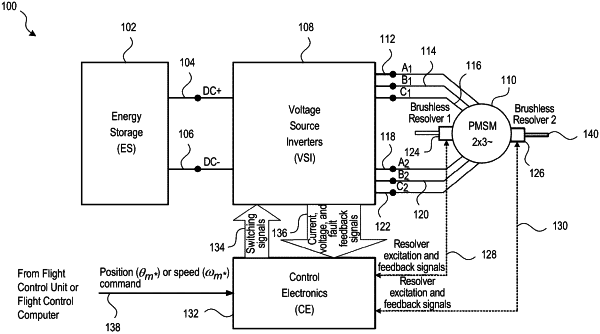| CPC H02P 25/22 (2013.01) [H02K 1/278 (2013.01); H02P 6/08 (2013.01)] | 19 Claims |

|
1. A fault-tolerant rotating electromechanical actuator, comprising:
a permanent magnet synchronous motor comprising first and second windings on a stator, each of the first and second windings comprising three phases;
first and second voltage source inverters configured to provide output signals independently of each other, the first voltage source inverter configured to provide a first set of output signals to drive the three phases of the first winding, the second voltage source inverter configured to provide a second set of output signals to drive the three phases of the second winding, the three phases of the first windings configured to be driven simultaneously with the three phases of the second winding; and
control electronics configured to monitor signals associated with the three phases of the first and second windings, the control electronics configured to detect a first fault condition that is located within a first phase of the first winding, the control electronics configured to command the first voltage source inverter to drive only second and third phases of the first winding and to command the second voltage source inverter to drive the three phases of the second winding simultaneously with the first voltage source inverter driving only the second and third phases of the first winding,
wherein the control electronics are further configured to implement interactive control loops for monitoring and adjusting the output signals to drive non-faulted phases of the first and second windings, the interactive control loops including a current loop configured to provide input to at least a flux weakening loop, the current loop further receiving reference currents, in the form of reference sums and differences, from the flux-weakening loop.
|